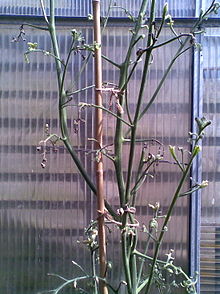- Aminopyralid
-
Aminopyralid[1]  4-amino-3,6-dichloropyridine-2-carboxylic acidOther names4-amino-3,6-dichloropicolinic acid
4-amino-3,6-dichloropyridine-2-carboxylic acidOther names4-amino-3,6-dichloropicolinic acidIdentifiers CAS number 150114-71-9 PubChem 213012 ChemSpider 184712 
Jmol-3D images Image 1 - Clc1c(nc(Cl)cc1N)C(=O)O
Properties Molecular formula C6H4Cl2N2O2 Molar mass 207.01416 g/mole Appearance Off-white powder Density 1.72 (20°C, relative to water at 4°C) Melting point 161.75 - 165.23°C
 (verify) (what is:
(verify) (what is:  /
/ ?)
?)
Except where noted otherwise, data are given for materials in their standard state (at 25 °C, 100 kPa)Infobox references Aminopyralid is a selective hormone-based herbicide manufactured by Dow AgroSciences for control of broadleaf weeds on grassland, such as docks, thistles, and nettles. It was first registered for use in 2005, in the USA under the brand name "Milestone".[2]
Aminopyralid is of concern to vegetable growers, as it can enter the food chain via manure, which contains long-lasting residues of the herbicide. It affects potatoes, tomatoes, and beans, causing deformed plants, and poor or non-existent yields. Problems with manure contaminated with Aminopyralid residue surfaced in the UK in June and July 2008, and, at the end of July 2008, Dow AgroSciences implemented an immediate suspension of UK sales and use of herbicides containing Aminopyralid. A company statement explained:
"Consistent with its long-standing commitments to product stewardship, and in cooperation with United Kingdom regulators, Dow AgroSciences has asked the Pesticide Safety Directorate (PSD) for a temporary suspension of sales and use of herbicides containing aminopyralid. The suspension shall remain in place until assurances can be given that the product and subsequent treated forage and resultant animal wastes will be handled correctly."[3]
As of July 2008, the following herbicide products that include aminopyralid in the UK include: Banish, Forefront, Halcyon, Pharaoh, Pro-Banish, Runway, Synero, and Upfront.
An online petition to the British government to "halt the use of Aminopyralid as a weed killer in British agriculture" gathered 1,459 signatures and the following response:
"Unfortunately the label prohibition on using manure that could contain aminopyralid on susceptible crops has not always have been followed when manure has been supplied to allotment holders and gardeners resulting in damaged crops. However the Government confirms that this has no implications for human or animal health."
"The manufacturers of aminopyralid products have now withdrawn their products from sale and the Government has formally suspended their approvals whilst they investigate the options for mitigating against a recurrence of this problem. Only when the Government is satisfied that the necessary measures to achieve this can be put in place will aminopyralid products be allowed back on the market."[4]
Despite restrictions, symptoms of aminopyralid damage were recorded on crops growing in allotments in Edinburgh, UK as recently as June 2010; enquiries traced the source of contamination to a farm supplying hay to the stables from where bags of manure had been obtained. Poisoning by aminopyralid affecting small farmers and gardeners was also reported in Britain in July 2011.[5]
See also
References
- ^ Aminopyralid - Compound Summary, PubChem.
- ^ Milestone FAQ
- ^ http://www.dowagro.com/uk/aminopyralidsuspension.htm Statement from Dow AgroSciences regarding suspension of Aminopyralid products in the UK
- ^ http://www.number10.gov.uk/Page17354 British government response to the danger of Aminopyralid for gardeners in the UK
- ^ Guardian article, 'George Monbiot, Have you spotted a strange curling disease in your home-grown veg?'
External links
Pest control: herbicides Anilides/Anilines acetochlor · alachlor · asulam · butachlor · diethatyl · diflufenican · dimethenamid · flamprop · metazachlor · metolachlor · pendimethalin · pretilachlor · propachlor · propanil · trifluralinAromatic acids Arsenicals Organophosphorus Phenoxy Pyridines Quaternary Triazines ametryn · atrazine · cyanazine · hexazinone · prometon · prometryn · propazine · simazine · simetryn · terbuthylazine · terbutrynUreas Others 3-AT · bromoxynil · clomazone · DCBN · dinoseb · juglone · mesotrione · methazole · metham sodium · sulfentrazone<5></http://www.scotsman.com/news/A-real-whodungit-as-keen.6343640.jp>
Categories:- Herbicides
- Pyridines
- Organochlorides
- Carboxylic acids
Wikimedia Foundation. 2010.

